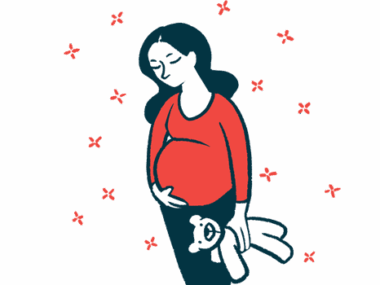Diabetes, high blood pressure in pregnancy may signal Cushing’s
Doctors missed Cushing’s signs in woman, per case study
Written by |

Doctors in England missed signs of Cushing’s syndrome in a 26-year-old woman with gestational diabetes and high blood pressure, a case researchers said highlights the need for heightened awareness and vigilance, particularly in pregnant women with those conditions.
“The diagnosis of [Cushing’s syndrome] in pregnancy is not straightforward due to various reasons,” the researchers wrote in a case report. “A thorough approach, including clinical evaluation, biochemical tests, and imaging studies, is crucial for accurate diagnosis and timely management,” they wrote in the study, “Cushing’s Syndrome Missed in Pregnancy,” published in Cureus.
Cushing’s syndrome, an umbrella term for disorders marked by high levels of cortisol, rarely occurs during pregnancy. When it does, its diagnosis is often challenging because its symptoms can overlap with those of a normal pregnancy.
When it occurs during pregnancy, Cushing’s syndrome is considered a high-risk condition. If it isn’t promptly diagnosed and treated, it’s associated with an increased risk of complications for both the mother and the fetus.
The most common cause of Cushing’s syndrome during pregnancy are adrenal adenomas, or benign tumors in the adrenal glands, which sit atop the kidneys and are responsible for cortisol production. Cushing’s disease, which is caused by tumors in the pituitary gland, rarely occurs in pregnant women.
Hypertension, diabetes in pregnancy
The woman in the case study developed Cushing’s during pregnancy. She arrived at the clinic with mild vaginal bleeding, but examination didn’t find a cause. An ultrasound confirmed she was six to eight weeks pregnant.
At 28 weeks of gestation, she was diagnosed with gestational diabetes. She was instructed to monitor her blood sugar levels and to make some changes to her diet. No insulin was required, but she later started on metformin, a medication used to control diabetes. At 31 weeks, she developed high blood pressure (hypertension), for which she was treated with labetalol and nifedipine. Despite treatment, her blood pressure at 35 weeks was still elevated, and she had proteins in her urine.
The woman underwent an emergency cesarean section at 36 weeks. The baby and the mother recovered well.
The obstetric team didn’t notice the typical features of Cushing’s syndrome during the pregnancy. But six months after delivery, the woman was referred to an endocrine consultant due to sustained hypertension and facial swelling. She displayed other typical features of Cushing’s, including easy bruising, purple stretch marks on the abdomen, and muscle weakness.
Further examination revealed that for three consecutive days, her urine cortisol levels were more than three times higher than normal, consistent with Cushing’s syndrome. Her blood cortisol levels failed to drop after an overnight dexamethasone suppression test, but she had normal levels of adrenocorticotropic hormone (ACTH), which normally prompts the adrenal glands to produce cortisol.
These results were consistent with the presence of an ACTH-independent form of Cushing’s and led researchers to order CT scans of her abdomen and pelvis. A mass found in the right adrenal gland was determined to be an adrenal adenoma.
The woman started treatment with ketoconazole, an anti-fungal medication that can lower cortisol levels and is used off label in the U.S. to treat Cushing’s. She eventually underwent surgery to remove the right adrenal gland. Her hypertension resolved and her Cushing’s features disappeared following the surgery. She received hydrocortisone until her cortisol levels normalized.
A year and a half after surgery, the woman became pregnant for a second time. She took hydrocortisone throughout the pregnancy and showed no signs of gestational diabetes or hypertension. She discontinued hydrocortisone nearly three years after adrenal removal surgery, and has remained asymptomatic and medication-free since.
“This case report highlights the critical need for maintaining a high level of suspicion for [Cushing’s syndrome] in pregnant women, especially those presenting with both gestational diabetes and hypertension,” the researchers wrote, adding that “early diagnosis and treatment are vital to minimize potential complications for both the mother and the foetus.”






